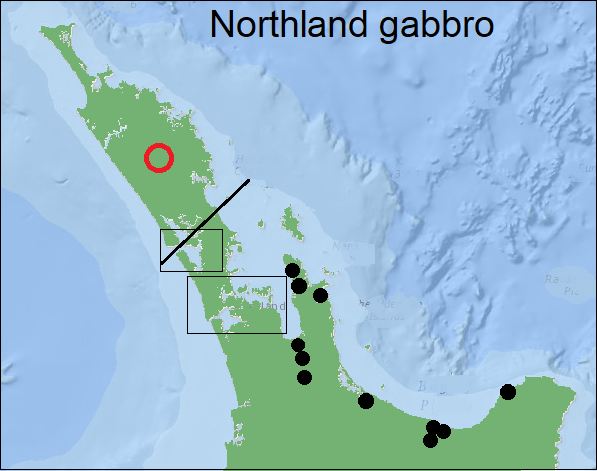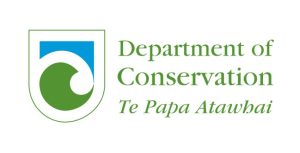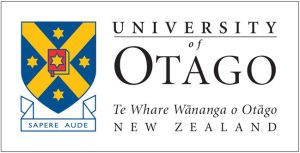Dr John Booth
Saturday 24.08.19 Session 4 Dr John Booth session on Voyaging within Aotearoa
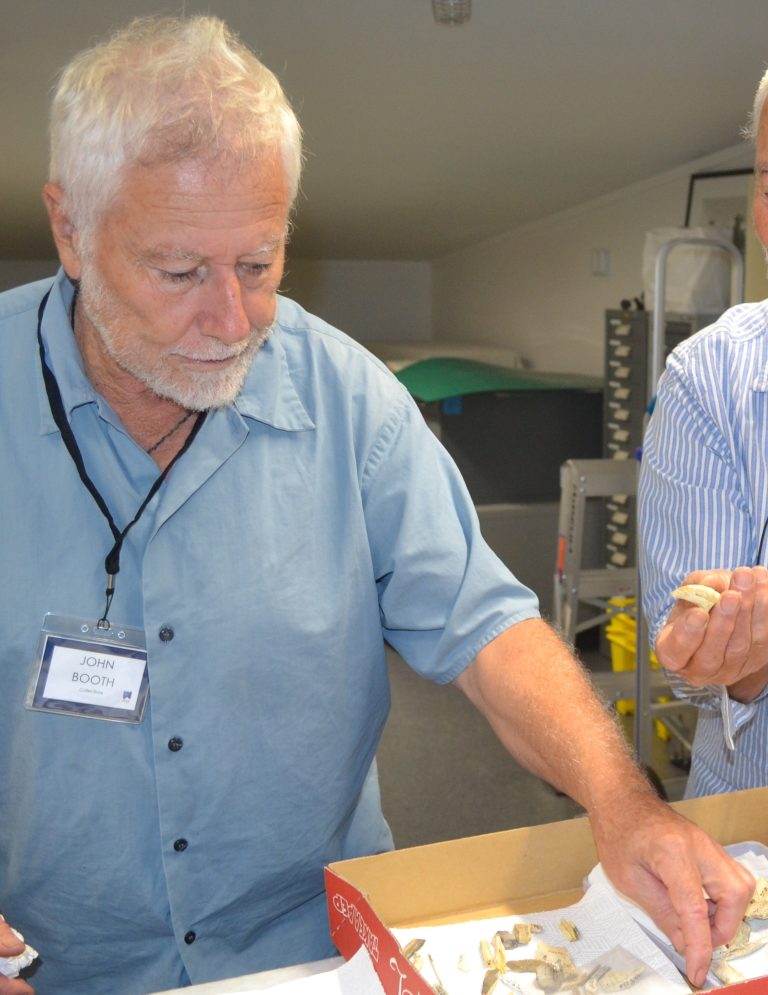
Te Tai Tokerau and Early Māori Voyaging
John Booth was a shellfish research scientist for NIWA, and from his expertise our archaeologists have learned much about shell artefacts and the contents of our middens. He has also been interested in other aspects of archaeology since his youth, including lithics. Booth’s contribution to the Voyaging Wananga begins to map the transport of stone, and other trade goods, along a network which he characterizes as “involving substantial oceanic passaging.” The great Māori wayfinders had turned their skill and their craft to carrying the abundant range of materials, many of them new to Polynesians, up and down Aotearoa’s complex and challenging coast, and along its many inland waterways. This korero analyses the artefacts of the Northland in the light of their place of origin, and the likelihood of how they reached Te Tai Tokerau.
Abstract
In pre-Contact times, northern New Zealand’s Te Tai Tokerau was arguably as much connected by long-distance waka voyaging to other parts of Aotearoa as had islands of the Hawaiki Zone of the South Pacific been previously linked to the archipelago of Aotearoa. This korero explores the evidence for transport from the south into Te Tai Tokerau of lithics such as obsidian and argillite, and the transport out of Te Tai Tokerau of lithics, as well as non-lithics, such as toheroa (Paphies ventricosa). Although it is seldom possible to categorically differentiate direct procurement of resources from down-the-line exchange, or long-distance trade, any lithic-dispersal at a significant level inevitably involved substantial oceanic passaging. These results further demonstrate outstanding voyaging and navigational prowess among early Māori – skills as highly developed as those of any other peoples in the world at the time.
Introduction
Waitangi in the Bay of Islands, venue for the August 2019 Tuia 250 Voyaging Wananga, is situated in the heart of Te Tai Tokerau, a region taking in the north of the North Island as far south as Kaipara Harbour-Bream Bay (see Figure 1). And for a time Te Tai Tokerau was arguably as much connected by long-distance waka travel to other parts of Aotearoa as had islands of the Hawaiki Zone (Cook Islands/French Polynesia) of the South Pacific, about 3500 km from Te Tai Tokerau, been previously linked to the archipelago of Aotearoa.
Aotearoa New Zealand was first permanently settled in a broad wave of immigration in the early-1300s AD (Walter et al. 2017), several sites in Te Tai Tokerau (many notable ones being in the far north of the region) being among the earliest in Aotearoa (Davidson 1981). And significant alongshore voyaging within the country after this settlement pulse is recognisable through the presence of lithics (rock resources) well beyond regions of native occurrence, and even in the probable long-distance transfer of certain perishables (Davidson 1984).
It appears that practically all major sources of rock suitable for manufacture of the adzes essential in early, large-scale undertakings such as waka construction (particularly Nelson/Marlborough argillite, and Tahanga basalt from the east coast of the Coromandel Peninsula) were known of by the 14th century (Davidson 1984), and were being transported great distances throughout the country. However, changes in the way adzes were fashioned and used, from flaked adzes as had been the method in East Polynesia to evolved bruised, pecked and polished adzes where a tougher stone was required (Turner 2005), meant that several early rock resources were little sought after the 15th century. This change coincided with – probably helped bring about – less long-distance voyaging on waka hauroa (double-hulled, ocean-going, sailing waka; Anderson et al. 2014), and, with burgeoning populations around the motu providing greater opportunity for land/river transport, the role of long-distance acquisition/delivery became increasingly difficult to distinguish from down-the-line transfer. Certainly, remarkable voyaging continued even into post-Contact (post-1800) times, as seen for example in Hongi Hika’s forays on waka taua (war canoes) into the Bay of Plenty (Anderson et al. 2014), but such vessels ferried warriors and little else. Remaining close to shore, they presumably stopped regularly for food, water and shelter as they travelled the coast.
This contribution explores evidence for the transport of lithics into Te Tai Tokerau from the south; and for the transport out of Te Tai Tokerau of lithics, together with plant and marine products. Although transfer of resources was often as much to do with gift-exchanges and strengthening of political relations or social ties (Davidson 1984; Seelenfreund & Bollong 1989) as anything else, this contribution deals only with physical procurement and delivery of materials. The medium of transport – land or sea, each with its particular merits (eg, Scott 2007) – cannot be categorically known in most circumstances, but certainly early in the piece (up to about the late-1500s), heavy materials such as rock would arguably have been transported primarily by ocean-going waka hauroa. Maps are provided that show not only where certain foreign materials have been revealed, but they are also indicative (although not categoric) around where such materials have not been found. Although the locating of foreign items in a landscape may be more appropriately considered in terms of mass of the material, state of reduction and so on (eg, Moore 2013), simple presence/absence is the basis of this synthesis; similarly, search effort analyses, to help establish nuances around dispersal strategies, are beyond this study.
Import of lithics
Through its long persistence in the landscape, rock invariably provides the most obvious and enduring evidence of human-mediated transfer. Stone and associated materials were used for adzes and chisels, hammerstones, grinders, rasps, sanders, saws and drill points – but also ornamentation, particularly in pounamu (nephrite) and kokowai (red ochre). Te Tai Tokerau (and Northland in general) is generally well supplied with cherts (Moore 2011), basalts (Best 1977), and obsidian (Moore 2012), but lacked stone that would fracture cleanly for early-style adze manufacturing. Accordingly, argillite imported from Marlborough/Nelson (most from the D’Urville Island-Dun Mountain mineral belt; Walls 1974), and Tahanga basalt from the east Coromandel Peninsula (Moore 1975), are found in early sites throughout the region (Figure 1) – typically as preforms or finished items, rather than as raw blocks of rock or their flakes (Turner 2005). Only Te Tai Tokerau’s obsidian can be accurately related to source (using XRF analysis); for other lithics, experience with visual characterisation of hand specimens from source locations is key, although there is growing confidence in geochemical and geophysical characterisations (eg, Phillips et al. 2017).
There were also notable early adze-manufacturing centres for northern New Zealand centred on Motutapu Island (Davidson 1981), using what has become known as Motutapu greywacke, with adzes of it known from several east-coast locations in Te Tai Tokerau. Greenstone (nephrite), known from Nelson, Westland, south Westland and Southland (Ritchie 1984, with apparently all but Southland exploited), has also been widespread in Te Tai Tokerau, particularly as adzes and ornaments found mostly in late archaeological sites (Davidson 1984). In particular, frequent finds between Cape Reinga and North Cape suggest an area wealthy and well populated for a long period, with well-established contacts as far afield as the South Island (Davidson 1984).
Of about 30 geographically-distinct sources of obsidian (volcanic glass, flaked and used to cut and scrape), the northernmost utilised were Pungaere (sometimes ‘Kaeo’) and Huruiki (Moore 2012) (Figure 2). But obsidian from many other sources is found in Te Tai Tokerau, that from Mayor Island having widest distribution here, and throughout the country, because of its purity and flaking-qualities.
Export of lithics
The broader Bay of Islands region was a source of obsidian not only for Te Tai Tokerau, but for places well beyond as well. Pungaere obsidian has been found in mainly-early sites as far south as Otago; although Huruiki obsidian has also been found well to the south, its main distribution is Bay of Islands to Whangarei (Figure 3).
With later changes in adze-making, the tough, basalt-like Northland gabbro became almost as broadly distributed as Tahanga basalt. Understood to have been sourced from ranges south of the Bay of Islands, it was widely used in Te Tai Tokerau and was also exported at least as far as eastern Bay of Plenty (Best 1977) (Figure 4).
Transfer of other resources
Other items exported and/or acquired included foodstuffs, cloaks, ornaments including mako shark-tooth pendants, feathers, tapa cloth, leaves, seeds and aromatic sachets (Firth 1929). And to this list for export south from Te Tai Tokerau might be added local perishables unavailable or uncommon elsewhere, such as taro, dried meat of certain warm-water fishes (tuna, marlin and so on) – and toheroa.
Early exports from Te Tai Tokerau would almost certainly have included the aute (paper mulberry, Broussonetia papyrifera) and the taro (Colocasia esculenta) introduced by the earliest settlers. Staple items in the economy of the Tropical Pacific, they could be grown here only in the north (Furey 2006).
Aute was used to manufacture tapa cloth by beating and felting strips of bark together. While in the Bay of Islands on Endeavour in 1769, Joseph Banks wrote in his journal ‘After this they shewd us a great rarity 6 plants of what they called Aouta [aute] from whence they made cloth like the Otahiti [Tahiti] cloth’, although use by this time was apparently confined to small pieces rolled up and inserted through perforated ear lobes. Consistent with wide-ranging export, in 1894 a certain Mr Matthewson found, in a rock shelter near Hyde in Central Otago, a 2-m long piece of tapa cloth (Hiroa 1924). And for taro, although any early exports will have left little in the way of signatures that current technology allow us to read, growing sites are plentiful in Te Tai Tokerau (Furey 2006).
A likely early, long-distance export from Te Tai Tokerau was the toheroa Paphies ventricosa. Large populations of this shellfish have existed along the west coast of Te Tai Tokerau and south to Muriwai, in the southwest of the North Island (Ōtaki to Foxton), and in Foveaux Strait (Te Waewae Bay and Oreti Beach) (Ross et al. 2018). Throughout, it was a fundamental food-item and traded commodity, being dried or smoked, as well as transported live. Genetic diversity is high in North Island populations, but low in the south, suggesting recent isolation – translocation by Māori being an obvious explanation. Furthermore, small populations became established from time to time on other North- and South-Island beaches, lending support to far-ranging attempts at translocation to establish new populations (Ross et al. 2018).
Nailing-down evidence for pre-Contact transfer of other non-lithic resources must await improved technologies, but, for later times anyway, ethnographic accounts come to the fore. For example, early in the 19th century white gannet-feathers were being prepared exclusively by Bay of Islands Māori for trade purposes (Nicholas 1817).
Discussion and conclusions
This korero, based largely on the literature, is still very much a work in progress: many records will have been missed, and new ones will be waiting in the wings within yet-unpublished accounts. Nevertheless, certain things are clear concerning the sheer extent of Māori long-distance voyaging around Aotearoa New Zealand – particularly in early times – with Te Tai Tokerau featuring as prominently as any other part of the country.
The dispersal of lithics is generally better understood than is that of non-lithics, by dint of their obvious endurance in the landscape – almost certainly leading to an unbalanced view around what voyaging waka might have stocked with. And Te Tai Tokerau appears to have been not only a destination, but also the source, of rock resources. Of particular note early in the piece (pre-1500) is the transfer of Marlborough/Nelson argillite and Tahanga basalt to the very top of the country – minimum straight-line sea-distances of 740 and 340 km respectively. The dispersal of Mayor Island obsidian reached its zenith at the top too, up to 420 km from source. And for greenstone, it is 930 km along the west coast from the Westland source, including the formidable Cook Strait.
Conversely, Huruiki obsidian found its way as far south as Foveaux Strait – a minimum sea-distance of almost 1800 km; and Pungaere obsidian to Otago was close behind, at 1580 km. But all of these may well have been pipped by the transfer of live toheroa from Te Tai Tokerau as far south as Foveaux Strait – around 1500 km along the west coast and 1900 km for the east coast.
Although the proviso stands that we cannot be categoric around how much of this was direct procurement via waka versus down-the-line exchange involving land/river-transport as well, there can be little doubt there was remarkable oceanic voyaging. The likelihood of distant waka-transport exclusively being involved varies with the commodity in question, and the age-context. Intuitively, a flake of Huruiki obsidian found well south may have simply represented an item of interest collected by one individual, whereas the transfer of sufficient live toheroa to establish viable populations out of their natural range presumably required careful planning and dedicated missions involving whole communities.
A return straight-line voyage from central Te Tai Tokerau along the east coast to Foveaux Strait of 3800 km is on par with the distance from the centre of the Hawaiki Zone to Te Tai Tokerau (3500 km). And on top of that, passaging around Aotearoa New Zealand inevitably meant dealing not only with winds and swells of unlimited fetch and the occasional cyclone, but also with the powerful, often serendipitous currents associated with a divided landmass blocking mighty current systems.
The navigational and distant-voyaging feats around Aotearoa New Zealand, particularly early in its settlement by East Polynesians, were, surely, as noteworthy as anything in the world at the time – and even in today’s terms.
References
Anderson A, Binney J, Harris A. 2014. Tangata Whenua. An illustrated history. Bridget Williams Books, Wellington.
Best S. 1977. The Maori adze: an explanation for change. The Journal of the Polynesian Society 86: 307–337.
Davidson J. 1984. The prehistory of New Zealand. Longman Paul Limited, Auckland.
Davidson JM. 1981. The prehistoric exploitation of stone resources in northern New Zealand. In: Archaeological studies of Pacific stone resources, Eds F. Leach and J. Davidson, Pp 107–119. BAR International Series 104.
Firth R. 1929. Primitive economics of the New Zealand Maori. George Routledge & Sons, Ltd., London.
Furey L. 2006. Maori gardening. An archaeological perspective. New Zealand Department of Conservation, Wellington.
Hiroa Te R. 1924. The evolution of Maori clothing. The Journal of the Polynesian Society 33: 25–47.
Moore PR. 1975. Preliminary investigation of the Tahanga basalt, Coromandel Peninsula. New Zealand Archaeological Association Newsletter 18: 32–36.
Moore PR. 2011. The definition, distribution, and sourcing of chert in New Zealand. New Zealand Archaeological Association Newsletter 20: 51–85.
Moore PR. 2012. Procurement and cultural distribution of obsidian in northern New Zealand. Journal of Pacific Archaeology 3: 17–32.
Moore PR. 2013. Obsidian sources of the Coromandel Volcanic Zone, northern New Zealand. Journal of the Royal Society of New Zealand 43: 38-57, DOI: 10.1080/03036758.2011.576684
Nicholas JL. 1817. Narrative of a voyage to New Zealand, Volume 1: 398–99. James Black and Son, London.
Phillipps RS, McAlister AJ, Allen MS. 2016. Occupation duration and mobility in New Zealand prehistory: insights from geochemical and technological analyses of an early Māori stone artefact assemblage. Journal of Anthropological Archaeology 42: 105–121.
Ritchie N. 1984. An analysis of nephrite artefacts from Pouerua, Bay of Islands. New Zealand Archaeological Association Newsletter 27: 181–188.
Ross PM, Knox MA, Smith S, Smith H, Williams J, Hogg ID. 2018. Historical translocations by Māori may explain the distribution and genetic structure of a threatened surf clam in Aotearoa (New Zealand). DOI:10.1038/s41598-018-35564-4.
Scott C. 2007. A cost-surface analysis of the exchange of obsidian in prehistoric New Zealand. New Zealand Journal of Archaeology 29: 57–87.
Seelenfreund A, Bollong C. 1989. The sourcing of New Zealand archaeological obsidian artefacts using energy dispersive XRF spectroscopy. In: Saying so doesn’t make it so. Papers in honour of B. Foss Leach. Ed. D.G. Sutton. New Zealand Archaeological Association Monograph 17.
Turner M. 2005. Functional and technological explanations for the variation among early New Zealand adzes. New Zealand Journal of Archaeology 26: 57–101.
Walls JY. 1974. Argillite quarries of the Nelson Mineral Belt. New Zealand Archaeological Association Newsletter 17(1): 37–43.
Walter R, Buckley H, Jacomb C, Matisoo-Smith E. 2017. Mass migration and the Polynesian settlement of New Zealand. Journal of World Prehistory DOI 10.1007/s10963-017-9110-y
Figure 1
Nelson/Marlborough argillite and Tahanga basalt adzes have been found widely throughout Te Tai Tokerau (southern boundary indicated by black line). Red circle denotes source; boxed area indicates region with multiple finds.
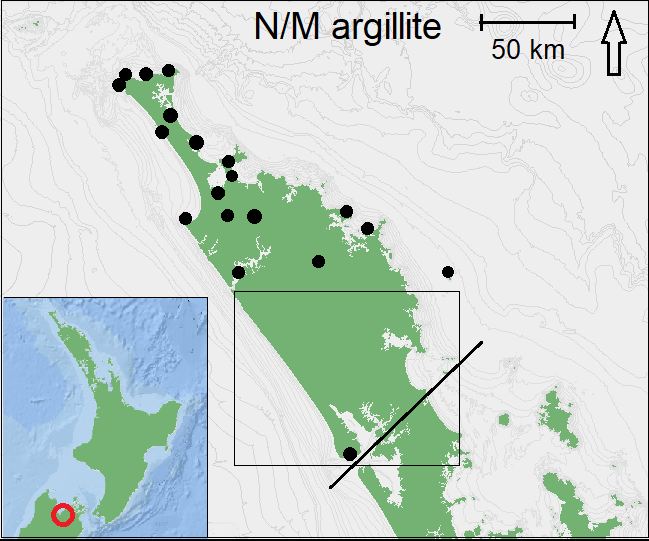
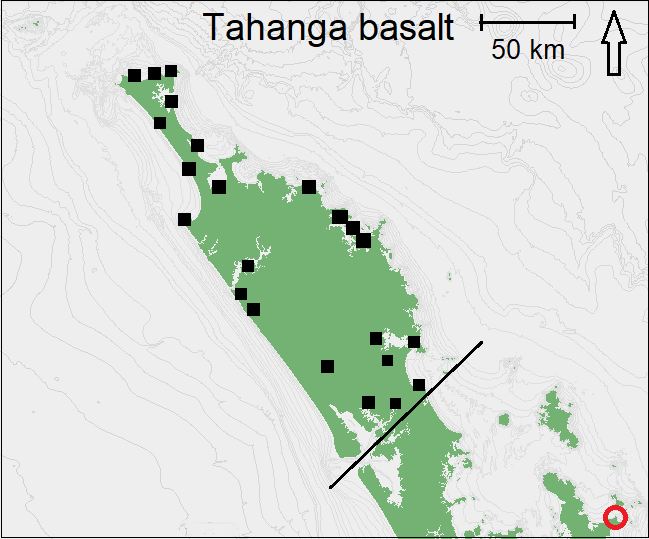
Figure 2
Obsidian is widespread throughout Te Tai Tokerau, coming from at least six distinct sources. Mayor Island obsidian is the highest grade and is found in both early and later sites. Red circle denotes source (see below for Pungaere and Huruiki obsidian).
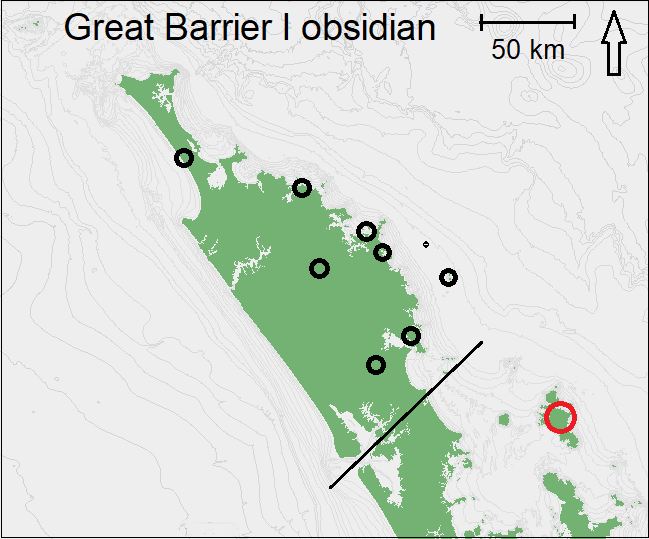
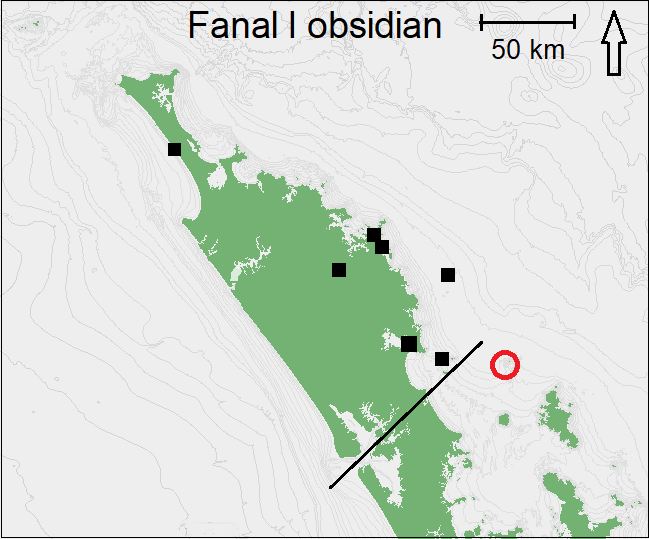

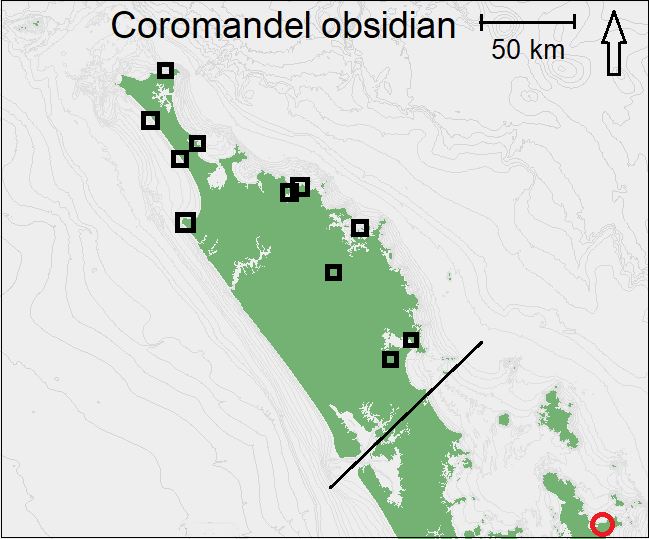
Figure 3
Both Pungaere and Huruiki obsidian are found not only within Te Tai Tokerau, but well south too. Red circle denotes source.
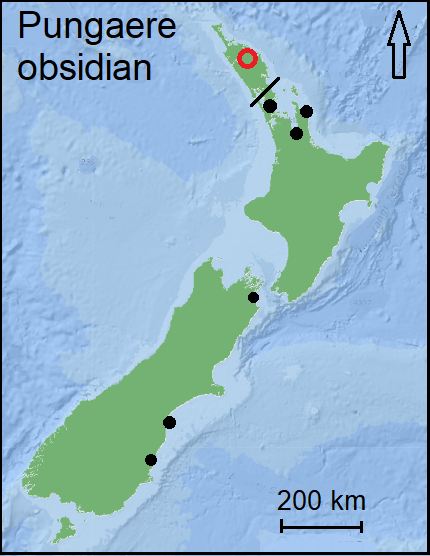
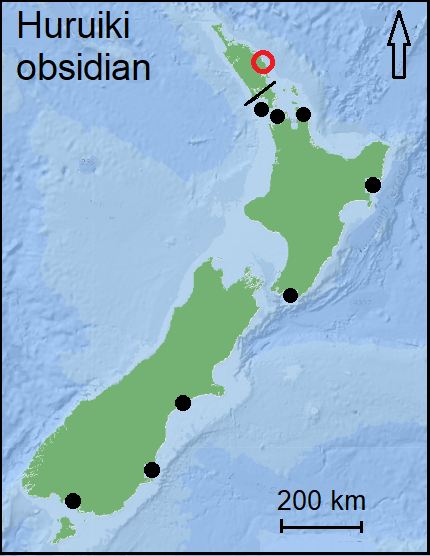
Figure 4
Northland gabbro adzes are widespread in Te Tai Tokerau and not uncommon to the south; boxed areas indicate regions with multiple finds outside Te Tai Tokerau. Red circle denotes likely source.
